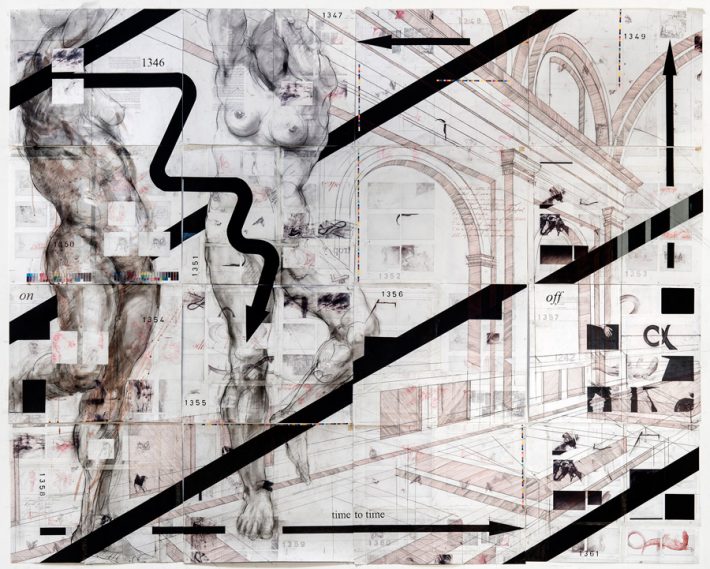The New Orleans Art Review | Spring 2016
VOL. 33, NOS. 3-4
By Kathy Rodriguez, via neworleansartreview.org
[EXCERPT]
JAMES DRAKE, VERNON FISHER, LEE DEIGAARD
Arthur Roger Gallery
New Orleans, LA

James Drake, Time to Time, 2015 | Charcoal, graphite, ink on book pages | 76 x 96 inches
FIGURATION AND LANDSCAPE still have a stronghold in contemporary painting, as currently evinced in five exhibitions at three different galleries. At Octavia Gallery and Callan Contemporary, respectively, Regina Scully and José-María Cundín visit these academic themes in a modernist, formal approach – analyzing color, line, gesture, and paint in works that shimmer with vibrant color. At Arthur Roger, two artists — James Drake and Vernon Fisher — approach them with collages of imagery, delving into personal history to make non-linear, and at times autobiographical, narratives. In the video space at Arthur Roger, Lee Deigaard’s photographs show the viewer the unseen landscape – darkened by night and populated with feral creatures. All the artists tap into a subconscious automatism and surreal intent in some form or another, embracing their themes through play, form, and concept.
…
At Arthur Roger, figure and text join within compositions in the work of two artists and friends, Drake and Fisher. Drake’s work populates the main gallery space. The title “Drawing, Reading and Counting” refers most directly to the artist’s practice of drawing every day for two years, and numbering the drawings which comprise the large-scale drawings mounted on the gallery walls. Their most obvious subject matter involves renderings of architectural space in perspective and figural studies of Drake’s transsexual friends, as noted in the press release. “Feynman diagrams,” methods of illustrating the activity of atomic particles in order to make better calculations in the study of physics, also link the drawings within the compositions and among the works on display. Though large in comparative scale to the figures and text, which become dreamy and surreal in their connections, the diagrams push toward the background, as though marking the path through the mental dreamscape that Drake depicts.

Vernon Fisher, I Am No a Monster, 2015 | Oil and acrylic on canvas | 45 x 54 inches
Drake’s friendship with Fisher is apparent in the links between their objects. Fisher, too, employs text, diagrams, and figures in his work, but these stem more from childhood associations. In “Distant Voices in a Foreign Language,” Fisher suggests the dream-like quality of listening to conversation that isn’t understood – and perhaps it is in the secret language of children. Cartoon characters from Disney and elsewhere shape the picture planes and the main figures within them, and gaze upon cosmos-like renderings of equations on blackboards or quiet and eerie Fischl-like suburban scenes. The awe, and nostalgia, associated with the images evokes feelings of the ephemeral and impermanent – much as childhood is experienced and lost except for its constantly fading memory.
These characters gaze upon a painting of a blackboard that reads as a dark sky – like children standing in wide-eyed wonder at the expanse of the universe before them. This experience of nature turns back toward the viewer in Deigaard’s photographs of animals. In “Night Vision,” she shows works from the Unbidden series, which depict wide-eyed animals via black-and-white night-vision photography. Their pupils dilated before the flash can shrink them, they edge closely to Deigaard’s lens, both curiously trusting and cautiously threatening in their proximity. The closeness of the multitude of photographs, hung individually framed and salon-style on the walls, immediately suggests both trophy rooms and the constant presence of these animals, seen or unseen, in their habitats surrounding us.
Deigaard forthrightly states that her work “portrays animal protagonists and the landscape we mutually inhabit,” but from the viewpoint of the photographer standing in awe before their presences. These creatures stare back in the way the figureless cosmos cannot. They are the faces of feral nature, stunned and stunning in their closeness to the camera, as Deigaard apparently automatically “shoots” the image, “taking” the likeness of the animal that presents itself to her lens. She is well aware of the parallel to hunting in her process, and likens her “trespass” to it both in nature and in the historical context of photography.
Though individually diverse, these shows connect in their subjects and forms. The personal, political, ecological, and historical threads that define each body of work form part of a larger fabric or framework in the broad subjects of figure and landscape. Whether by process or associations, the early twentieth-century practice of making connections by games and play via form also seems apparent in the work, and the artists each have their own way of literally putting pieces together. Whether in elemental forms or fragments of memory and experience, those pieces create specific personal and at times subconscious narratives for each artist. It is the viewer’s game to place them in the larger context, and participate in the practice. These artists show freshness in their approaches to timeworn themes, and that by itself is compelling.
